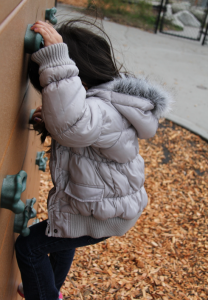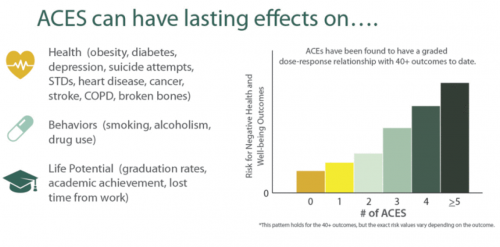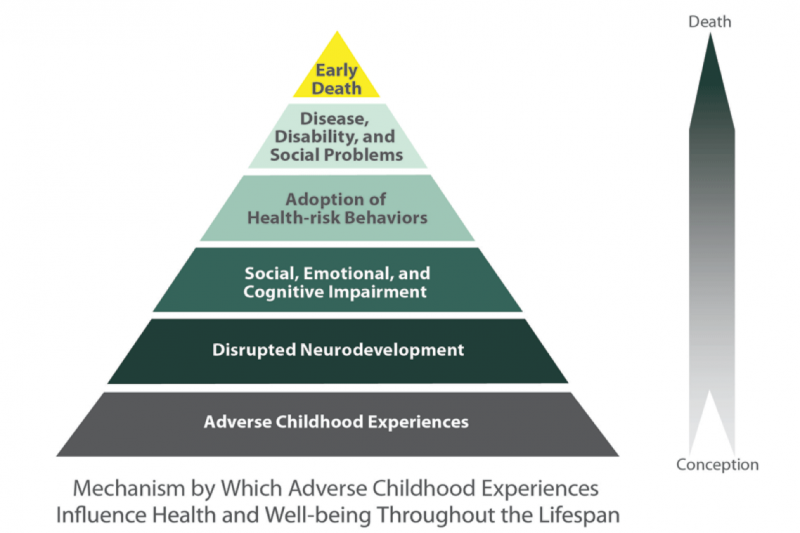13-2 Adverse Childhood Experiences
A – Impact of Children’s Experiences

We know that young children’s experiences can have a lifelong impact. This is true of both positive and negative experiences.
In the 1990s, the Centers for Disease Control and Prevention (CDC) partnered with the health care company Kaiser Permanente to quantify the impact of childhood abuse and neglect on later-life health and well-being. Early life negative experiences have come to be referred to as adverse childhood experiences, or ACEs.
Research from the original study and others have linked ACEs to:
- Risky health behaviors
- Chronic health conditions
- Low life potential
- Early death
Importantly, as the number of ACEs increases, so does the risk for these outcomes.
However, adversity early in life does not necessarily result in poor life outcomes. With the help of supportive adults in their lives, children can recover from early life trauma.
Let’s take a closer look at the original study and how adults can provide support for children who are experiencing abuse, trauma, and neglect.
ACEs: Three Groups
Again, to better understand ACEs, the CDC and Kaiser Permanente conducted surveys with more than 17,000 Kaiser Permanente patients.
Participants received a survey in the mail asking a series of questions about the presence of adverse experiences in the first 18 years of their life as well as questions about their physical and mental health.
In the study, ACEs were categorized into three categories:
- Abuse
- Neglect
- Family and household challenges
Within each category there were multiple sub-categories. Take a moment to read through this list of ACEs on the table below.
| Abuse | Neglect | Household Challenges |
|---|---|---|
|
|
|
 Interactive: Participants in the ACEs Study
Interactive: Participants in the ACEs Study
This is an interactive! Use the slider to explore the graph.
Potential Lifelong Effects
The study found a strong link between ACEs and a long list of poor life outcomes. The more ACEs a person has in their lifetime, the greater their risk for these outcomes.
As the number of ACEs increases so does the risk for:
- Alcoholism and alcohol abuse
- Chronic obstructive pulmonary disease
- Depression
- Fetal death
- Health-related quality of life issues
- Illicit drug use
- Ischemic heart disease
- Liver disease
- Poor work performance
- Financial stress
- Risk for intimate partner violence
- Multiple sexual partners
- Sexually transmitted diseases
- Smoking
- Suicide attempts
- Unintended pregnancies
- Early initiation of smoking
- Early initiation of sexual activity
- Adolescent pregnancy
- Risk for sexual violence
- Poor academic achievement
This list is not exhaustive. Note that the list here is longer than the one on the slide. For more outcomes see the CDC’s Adverse Childhood Experiences Journal Articles by Topic Area (reference below).
Cumulative Effects

Again, the more ACEs a person has, the greater their risk of having health problems such as obesity, diabetes, depression, heart disease, and even cancer.
Part of this may be because the more ACEs a person has, the more likely a person is to engage in harmful behaviors like smoking, alcoholism, and drug use.
And finally, people with more ACEs tend to have lower graduation rates and more time lost from work.

Reflection Point
Consider the following question:
Why do you think ACEs have such strong and lasting effects on people’s lives?
B – Effects of ACEs
CDC Model
To help understand why ACEs have such long-term impacts, the CDC has developed this model that explains how early experiences influence the rest of our lives. Research indicates that ACEs can disrupt the formation of key circuits in the developing brain, especially those needed for learning and success in school. The disruption of these circuits can lead to social, emotional, and cognitive impairment.

These impairments predispose people to adopt high-risk behaviors like drug and alcohol use. These high-risk behaviors can increase the risk of disease and disability, which in turn can lead to an early death.
Early adverse experiences can set in motion a cascade of outcomes from altered brain circuitry to predisposition to high-risk behaviors.
 Interactive: ACEs are Common
Interactive: ACEs are Common
This is an interactive. Use the slider to explore the graph.
This means that a large percentage of the population is facing poor health and life outcomes as the result of their experiences as children. ACEs aren’t just a problem for certain communities, they are a problem for ALL communities, touching the lives of almost everyone.
ACEs Can Cause Toxic Stress
Prolonged and intense stress from ACEs can:
- Cause toxic stress.
- Impact the developing brain.
Toxic stress can cause trauma. Trauma is the psychological, emotional, and physiological residue that remains after children experience continued levels of toxic stress from living with high levels of danger, violence, life-threatening events, and critical loss.
 References
References
Minnesota Department of Public Health. (2019). Stress and ACEs: ACEs have an effect on the developing brain. [Online Article]
U.S. Department of Health and Human Services, Centers for Disease Control and Prevention. (2020). Adverse childhood experiences. [Website]
U.S. Department of Health and Human Services, Centers for Disease Control and Prevention. (2020). About the CDC-Kaiser ACE study: The ACE pyramid. [Website]
U.S. Department of Health and Human Services, Centers for Disease Control and Prevention. (n.d.). Adverse childhood experiences: Looking at how ACEs affect our lives and society. [Website]
Zero To Three. (2016, March 7). Trauma and toxic stress. [Online Resource]
EarlyEdU Alliance (Publisher). (2018). 13-2 Adverse childhood experiences. In Child Development: Brain Building Course Book. University of Washington. [UW Pressbooks]

